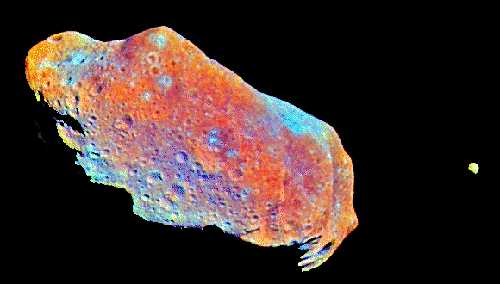Planetary scientists believe that meteorites falling to Earth begin their journey as asteroid chips, rock fragments ejected during collisions among the “main belt” asteroids orbiting between Jupiter and Mars. But the most populous class of meteorite — ordinary chondrites (OC) — look bluer than the S-class asteroids scientists presume to be their parent bodies.
One explanation for this discrepancy holds that long-term exposure to space itself somehow “weathers” surfaces, making them redden with age. In a paper published in this week’s Nature, a team led by Robert Jedicke of the University of Hawaii’s Institute for Astronomy provides convincing evidence that asteroids do, in fact, change color as they age.
The team’s first step was to identify asteroid “families,” groups of related objects formed by the disruption of a larger body. Most of these fragments came from within the original body and were never exposed to space, so family members show a common age. The team looked for clusters in asteroid “proper elements,” orbital elements averaged in a way that removes short-term variations caused by the gravitational influence of the planets. Family members share very similar proper elements.
The most reliable age estimates came from numerical integration of the orbits of asteroid family members. For families younger than about 10 million years, computers can step the orbits of their members backward in time until their orbits share a nearly identical orientation in space. This marks the time of the collision that created the group. For older families, the scientists relied on other estimates — such as the spreading of asteroid orbits due to thermal effects.
Jedicke and colleagues next found high-quality color measurements for 8,416 asteroid family members in the Sloan Digital Sky Survey Moving Object Catalog. The “asteroids get more red with time in exactly the right manner and at the right rate to explain the mystery of the color difference between them and OC meteorites,” Jedicke said.
“Space weathering” was proposed to explain the color change about thirty years ago. Meteorites, whose surfaces are affected by their fall through Earth’s atmosphere, usually are studied in laboratories by observing freshly cut and exposed interiors. Scientists suspected that the same material, exposed for millions of years to small impacts and to solar and cosmic radiation, might change color in exactly the manner required to match the color of asteroids. “Even though we have found a link between the two types of objects, we still don’t know what causes space weathering,” he noted.
Jedicke told Astronomy that there were similarities between his study and recent work on the smaller satellites of Jupiter and Saturn. Astronomers class those moons with highly inclined and eccentric orbits as “irregular” and believe that many are captured asteroids, some possibly broken apart when the giant planets ensnared them.
“Finding families of irregular satellites is a little easier,” he said, “because there are so few and the clumps stick out with little background.” Colors haven’t been measured well, but “it is possible to date the time of the collision that produced the families, measure the mean colors, and look for a similar effect as to what we identified in the main belt,” he explained.
But “weathering” in the vicinity of Jupiter and Saturn might be quite different from what happens in the main asteroid belt. “This is certainly something that people will be looking at now,” Jedicke noted.










